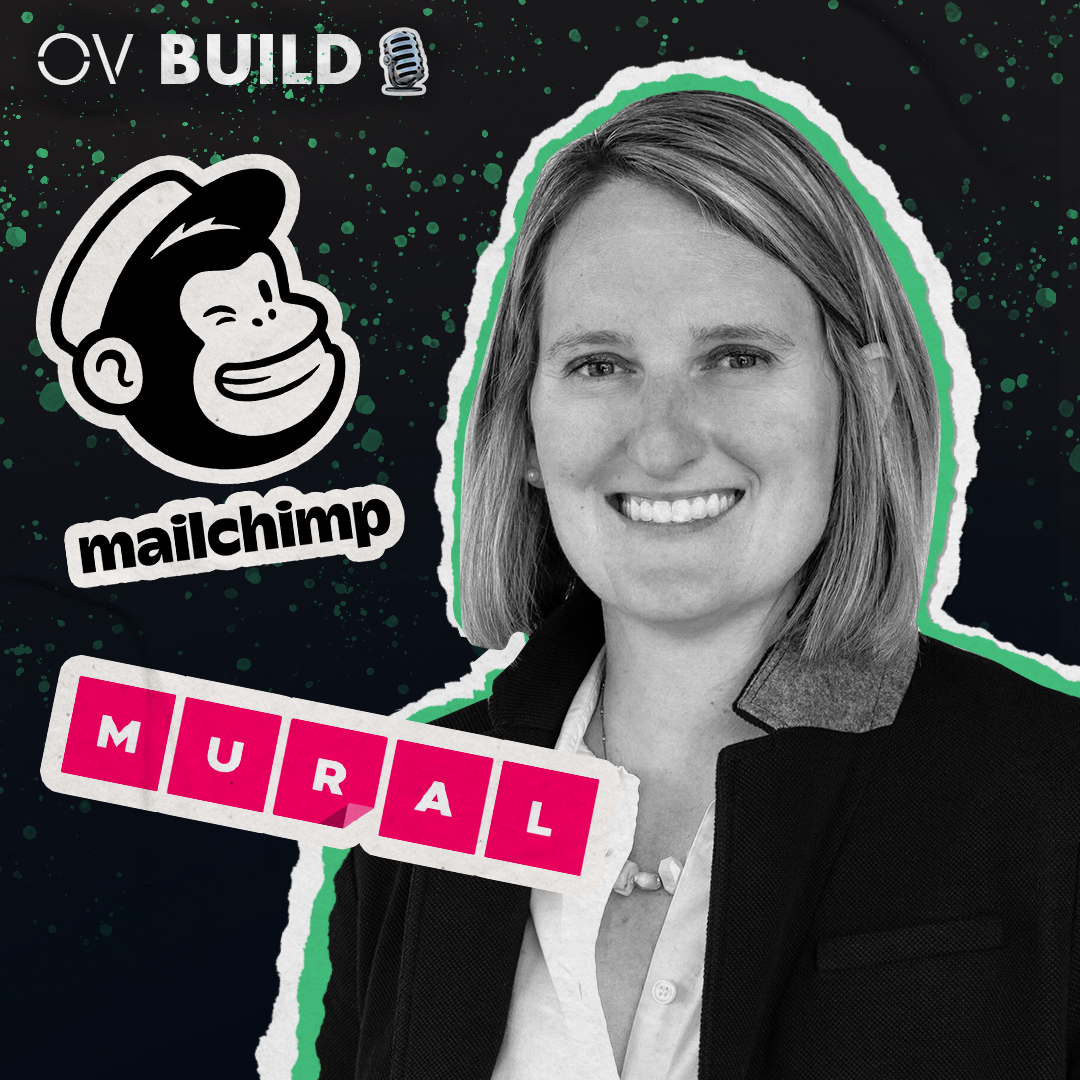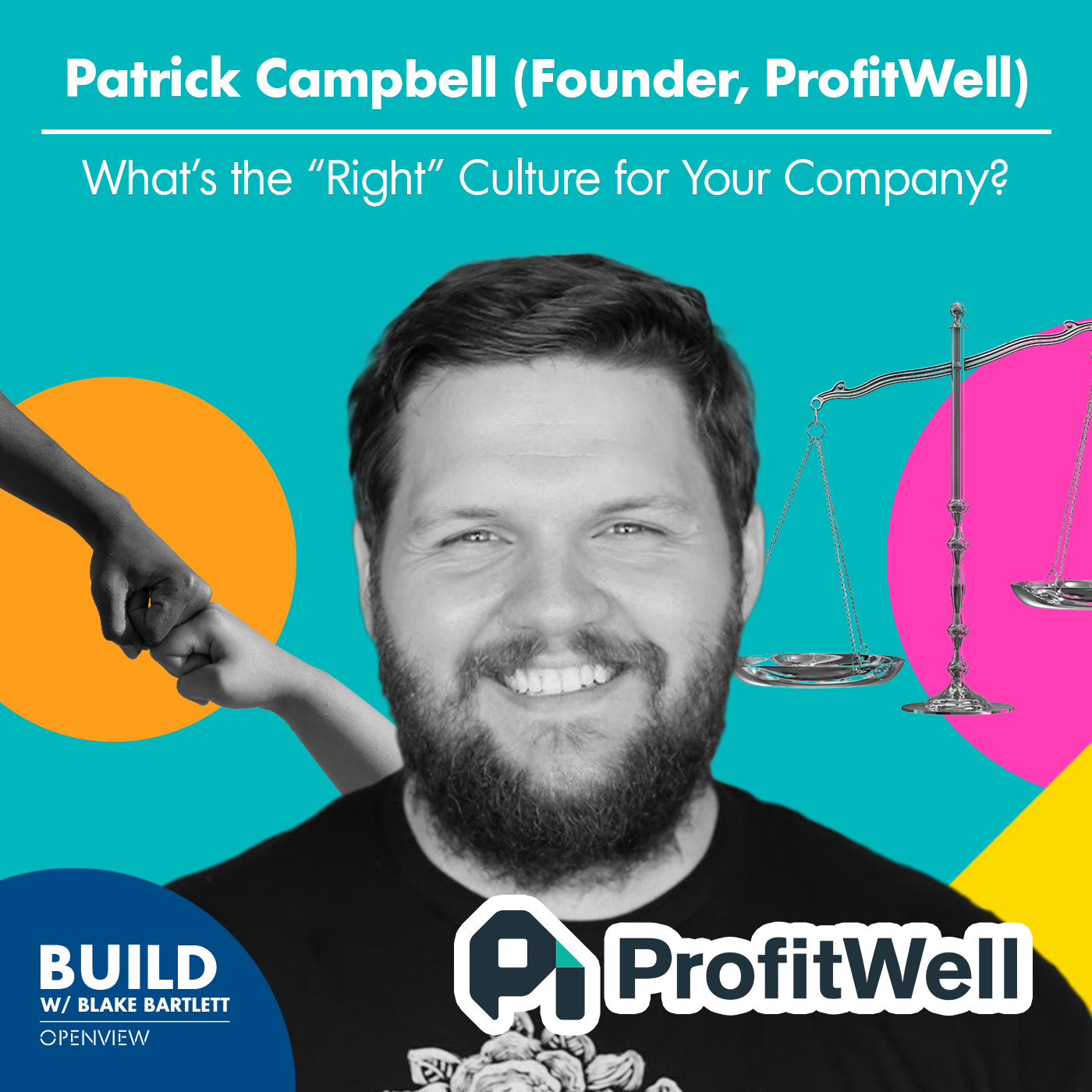Lauren Schuman (Mailchimp & MURAL): Growth Needs Marketing
- 0.5
- 1
- 1.25
- 1.5
- 1.75
- 2
Blake Bartlett: Welcome back to the Build Podcast. I'm Blake Bartlett, a partner at OpenView. We're here to help software founders and operators identify and unpack sustainable growth strategies in the ever- changing world of SAS. Today, we hear from Lauren Schumann. When we spoke, she was the senior director of product insights and growth at MailChimp. She has since joined MURAL where she is now the VP of product growth. In today's episode, we unpack Lauren's firsthand experience starting and scaling MailChimp's growth team. The power of internal marketing, that's marketing to your own colleagues and why it's important to focus on inputs over outputs when it comes to improving growth KPIs, all that, and more in this episode of Build. So let's dive in with Lauren Schumann. Well, Lauren, thank you so much for joining us here on the Build podcast. It's great to have you on the show and I want to jump straight into one of your biggest claims to fame, which is that you started the growth discipline at MailChimp, and that is huge. So I would love to hear, and I'm sure the audience would as well, the backstory on growth at MailChimp and what that story and journey has looked like.
Lauren Schumann: Blake, thank you so much for having me here today. So let's talk about growth at MailChimp. I was hired a little less than four years ago now, I guess, by our CMO. And it was into a role called director of marketing optimization. It was a new role with no team in place yet, sort of lots of potential to solve problems, but no clear vision on the particular role. And I had the opportunity to shape the role based on the problems that I heard through things like stakeholder interviews and really just getting a lay of the land for what was happening at MailChimp at the time. And so that role ended up being a combination of marketing focus growth and building out an experimentation practice. But my longer term goal was really to convince the organization that, and especially product leadership who was very skeptical at this point in time, that a growth practice would really be helpful for MailChimp specifically reaching a lofty paid user goal that we had set forth for the company at that time. And so after some strategic experiments and wins on the marketing side of the house, I was able to really get excitement and momentum to get growth off the ground at the company. And it wasn't until that time that I actually moved into product, my direct reports with me and we created the very first growth team. It was a growth domain. MailChimp is organized in sort of domains in squads. And what was really cool about it is we took the existing marketing cross- functional team that was working on growth. And we actually combined it with an existing product team that was called continuous onboarding. They were working on, and I think it was like a dashboard revamp at the time. And that project was really struggling because they were trying to build it in a way that they would build core product, but instead of driving specific outcomes. So it was a really great combination of marketing and product together to try growth for the first time.
Blake Bartlett: Well, it's a really interesting answer to the age old question of should growth live in marketing or should growth live in products? There's a little bit of both there. You started in marketing and then over time growth migrated over to product, but it did so in a very cross- functional manner that pulled in marketing and pulled in product under the same umbrella. So it really loves that cross- functional illustration there. I'm curious, given that your background is as a marketer and you initially came into MailChimp on the marketing team, how has that marketing background helped you now as a product and growth leader?
Lauren Schumann: I think what is kind of a new background and approach to marketing. I have an undergrad degree and a graduate degree in marketing, but I've actually held very few traditional marketing roles. And more often than not, I've actually not been in the marketing department in a company. I think MailChimp is only the second time in my career, but this was really by design because I like applying this marketing oriented mindset to product. And that's when growth started to emerge as a practice that was like the perfect fit for my skillset because it sits at that intersection of product marketing. And I might say like data and analytics, I find that a lot of marketers don't speak product super well. And a lot of product folks don't speak marketing very well, which can make collaboration between the groups kind of bumpy. And it also makes solving things like complex problems related to monetization, very difficult. You need to get a sense of not only what to sell and how to sell it, but also how does that tie to product value, product usage. And so with my marketing background, I feel like I've often been able to sort of be that bridge between marketing and product. And it's helped me serve as a connector to facilitate better and more joint problem solving.
Blake Bartlett: And other side of that coin, are there anythings that having come from marketing and now being in product and growth that have been challenging or things you've had to navigate compared to somebody who maybe has spent their entire career in product?
Lauren Schumann: Yeah, that's an emphatic yes. And when I was first getting the growth domain off the ground at MailChimp, I learned pretty quickly that there are some existing product folks that were very weary of a marketer joining as sort of their leader. They had this view of marketing as being kind of icky, which is kind of ironic since MailChimp is a marketing technology, but there was this fear that, as a marketer, I was going to come in and try to just endlessly sell stuff through the product. And I had to eventually earn their trust by showing them that marketing is a lot more than just selling. And I also really got them bought into the problem we were solving. So things like participating in ideation together, reviewing data and research to learn and even reviewing experimentation results really helped get folks to see me as beyond just a marketer, and to understand really a lot more of what marketing means than what they originally thought.
Blake Bartlett: And I like how you brought in that example of product marketing as one example there, because that oftentimes is that sort of natural join point for product and marketing to come together because if the product is being built and it's meant for a particular end user and it's solving a particular pain point, you also have to make sure you're messaging that value and why that user should care about the product in the appropriate way. And so that's a natural sort of jumping off point, but there are so many others as well that creates that collaboration opportunity between product and marketing. And I know you have a few examples, and one of the examples that, that stood out to me the most was how you leveraged the concept of an internal marketing at MailChimp. So could you unpack that? What does internal marketing mean and what did that look like for you all?
Lauren Schumann: Yeah, so because growth was new to MailChimp, there were supporters, but there are also some folks that were weary of the practice. And I felt like visibility and transparency into the work was really of the utmost importance for the team to be successful. And so since MailChimp is a marketing tool, I thought it might be kind of a good way to build empathy for our users if we were to act as if we were a small business, and we were this content network and our goal was about sharing useful information and knowledge across the organization. But we wanted to do it in a way that was attention grabbing. It was fun. It was interesting. It wasn't just your usual Slack message or your email. And eventually I encouraged us to think about our mission in terms of creating an internal marketing and communications plan.
Blake Bartlett: And so what did that plan look like? I know that there was a few different channels internally that you leveraged for the internal marketing campaign.
Lauren Schumann: Yeah, so some of my favorites are, I guess probably some of the most creative examples. One was a monthly newsletter. Of course we used MailChimp, so that was a great opportunity to use the product, but we would share things like example, live experiments, what some of our most important learnings were. And they weren't just some boring newsletter though. They often had a theme to them like the office, or I remember Dirty Dancing was one of them since that's one of my all time favorite movies, but they were basically something that was made to be engaging and clever. I was actually thinking back to some of the favorite newsletters and some of the headlines. And one of my favorites was nobody puts AB in a corner, or test me AB one more time, as you can see, we got kind of silly with it, but it really got people to engage with the content.
Blake Bartlett: So, you're using, in many ways, the MailChimp brand voice to market internally and bringing in that playfulness and bringing in that ability to grab the attention of the reader, whether it's an external reader or whether it's an internal reader. And, for me, that's one of the most awesome and unique elements of the MailChimp brand and the MailChimp brand voice. And so it's really cool to see that you're directing that both internally as well as externally.
Lauren Schumann: Yeah, definitely. I think the brand's really important to think about in terms of our internal culture, as well as external. And there's a lot that we live internally. I think another great example is that MailChimp has an internal radio station called Kip TV. And so one of the other interesting bays we tried to get attention was we ran a radio hour where we featured sort of specific learnings represented by a specific song. It was a really fun way to engage people for them to hear music and content, but to relate our work to something fun that wasn't simply, again, like sending an email or sending a Slack.
Blake Bartlett: And there was also the example of, in addition to the internal radio station, you also had an internal podcast too, correct?
Lauren Schumann: Yeah. So Fred Talks was a podcast that also is on Kip TV and we had the opportunity to do hot ones. I don't know if you've seen the hot ones videos before, but where you're basically eating really hot wings and answering difficult questions. And so that was one of the other really creative approaches that we took to sharing important content.
Blake Bartlett: And Fred Talks because the name of the mascot is Freddy, right?
Lauren Schumann: That's right.
Blake Bartlett: So, pulling on the Ted Talk, have a play on words that I love it. So diving into some of the specifics, were there examples of things that you communicated to the team that resonated more than others? What was the internal audience most excited to hear from the newsletter or from the Fred Talks that would drive impact internally?
Lauren Schumann: I think the most important and impactful things be shared where the learning, so not necessarily the specific experiment results, although people enjoyed nerding out over that sometimes. But a lot of times they were really interested in sort of the synthesis of experiment plus research plus analysis and what that means for the business. And we wanted to be able to share that beyond growth so that it could impact other product and marketing teams. And so I think through some of these creative outlets, we were able to really send that message.
Blake Bartlett: And zooming into growth teams specifically and unpacking that a bit more. So, first off, what is your definition of success for a growth team?
Lauren Schumann: Yeah, so I think a growth team should really have a clear understanding of the business impact that is indicated by success for the team, usually through something like a North star metric. But I do think it's easy to over- index on moving a metric as success. From my experience, a growth team really is successful when it's value extends beyond the work that that team physically does. I think it's successful when it expands into influencing like strategy marketing and product decisions really across the company. So, like at MailChimp, the value of the growth team has really been the learning even more so than the incremental revenue gains that we have driven.
Blake Bartlett: And so it's kind of this idea that success is a growth team. Sometimes it might be things that your team is actually doing directly, but other times it might be ways in which you identify learnings and insights through experimentation, and then the work ends up getting done through other teams. And so it again brings back that cross- functional idea, but it also brings up the idea that you are working through an influence manner through other teams to deliver those impacts and to drive change.
Lauren Schumann: Yes, totally agree with that.
Blake Bartlett: And one example you gave me before was the idea of pulling on this North star metric idea was activation. And so how do you think about activation at MailChimp and talk a little bit about that challenge of trying to move the activation metric?
Lauren Schumann: Yeah. So defining activation was one of the first things we did as a growth team. It required us to do some analysis as well as just really thinking through how the product is utilized and how you get to that core value, that aha moment. And for us, we were able to determine that was about sending a campaign to 10 plus people in your first 30 days. And our North star metric was really about driving paid users and we were able to tie activation behavior to a significant increase in pay conversion. And so that's how we netted out on that focus.
Blake Bartlett: And you mentioned that there can be inputs to a North star metric or a growth KPI, and that it's possible to influence the inputs without actually seeing a change in that ultimate North star metric or growth KPI that you care most about. What does that look like in practice and how do you know when that's happening to you?
Lauren Schumann: Yes, so we worked for over a year on driving activation and we did eventually see some marginal improvement, but we were a bit disappointed. It wasn't to the degree that I think we had hoped going into this work. We ran a bunch of experiments. We did a bunch of analysis. We did research and as we launched improvements, we did see inputs increase, but we weren't really able to tie that to a large increase in the activation rates. So when I say inputs, I mean, things like draft creation, list upload, these are really important steps to getting to the activation moment. And while we were able to improve them, what we were starting to learn is that it required a bunch of those changes together to make even some significant change to the activation metric, but it still wasn't amounting to what we needed it to be.
Blake Bartlett: And so you're running all these experiments. You're looking at the inputs and seeing some change in the inputs are those initial steps that lead to activation, but not seeing activation itself move in a meaningful way. And it sounds like that caused you to take a step back and it led to a bigger realization of something that it needs to change in the core product. So what did that look like and how did that unfold?
Lauren Schumann: Yeah, we were starting to get frustrated and our leadership was too. I think we had realized that we hit some sort of local maximums within the space that we were playing in. We had optimized specific parts of the experience, really, to the best of our ability. And I credit the growth PM Carrie, who was leading that squad at the time. She decided that we really needed to take a step back and kind of do some qualitative research just to better understand why we were stalled, what was happening that we were missing between our experiments, our research that we'd done so far in the data. And so in partnering with one of the UX researchers, the team actually conducted a usability study and that was the catalyst that kind of changed our entire perspective. The team learned I'd say two key things through that study. One was that it was like the liminal spaces, the spaces in between the navigation, that was a part of the issue. So if we fixed list upload or a fixed draft creation, that was great, but we weren't necessarily looking at that holistically enough. And then the other piece was that the editing experience just had several issues in it that had caused people to abandon. At the time our email editor was part of the core product. So it was pretty old. It was pretty brutal in terms of the technology. There was a lot of tech debt. And I remember the engineers that had worked on in the past were extremely weary of trying to run any experiments on it, or it was kind of just like, don't mess with the thing because we don't want to break it and take down the whole application. But based on the data we had, the tech debt, and the belief that there was a lot of room to improve in that experience, we were able to convince the product organization to invest in rebuilding the editor. And so we actually passed that project off to another team who spent about six months working on rebuilding that experience.
Blake Bartlett: And to clarify, perhaps, the obvious, but the editor for an email marketing product is pretty central to the core product itself, right?
Lauren Schumann: Yes. It is probably the most important part of the product.
Blake Bartlett: And so what did that look like? I mean, was that a multi month, multi quarter effort to rebuild the editor, or once you had that realization, how long did it take to then get the impact that you were looking at?
Lauren Schumann: Yeah, so it was a significant lift, I'd say about a six month process. The good part about it was we were going into it with a lot of information about what specifically needed improvement. So when the team went to build, they had ideas about what worked from a design perspective and they didn't have to do necessarily as much research as maybe they would have had to do otherwise. And when we first launched, we launched it in a more scaled back version and over time have been adding more and more functionality to it, so that eventually we can deprecate the old editing experience and move everybody onto the new editing experience.
Blake Bartlett: And what were some of the biggest things that needed to be updated in the editor?
Lauren Schumann: So we were just behind on some of the technology, things like image editing and image sizing, that's a really important part of content creation. And we made it pretty difficult to do that through our content editor. Whereas some of the best practice was to be able to drag and drop it and easily do it yourself. So a lot of it was modernizing some of the editing features, but we learned through a lot of our research that content creation was actually the number one blocker to people sending their first campaign. So we spent a lot of time on those specific elements around the content creation
Blake Bartlett: And what ended up being the ultimate impact, then, to activation after all of that was said and done?
Lauren Schumann: I wish I had a specific metric for you. We're still in progress of phasing between the two editing experiences. So I don't have anything concrete I can share.
Blake Bartlett: But it does illustrate this idea of back to the very beginning of our conversation, which is that growth is fundamentally a cross- functional role. And that even if you are running experiments and running an experimentation program on the growth team, it might lead to insights that ultimately get delivered through another team and it might be through another team. And it might take a lot of time as well. I mean, this example of needing to identify core elements, very core elements of the product that needs to be rebuilt in order to improve usability. And then that kicking off a six month effort to actually rebuild that aspect of the product. It just really underscores that idea that the definition of success for a growth team is often times through working through others and delivering impact through others versus just first party activities on your own team.
Lauren Schumann: Yes, I agree. Very well said. I think there's a tendency to think about success as what did my team deliver, but in this particular instance, the growth team, wasn't the right team to build the new editing experience. And we had done the legwork to prove out the value of improving the editing experience. I think others had maybe suggested that in the past, but without the business case solidly there, it was really hard to make that decision to invest.
Blake Bartlett: So we've been talking about your experience at MailChimp and the impact that you've had there, but you've now moved on to a new adventure. Tell us a little bit about that.
Lauren Schumann: Yeah. So I have had the opportunity to join MURAL as VP of product growth. And if you're not familiar with MURAL, they are a digital collaboration tool for virtual work, which is really exciting given the environment we're in and just how important virtual collaboration has become and will continue be. MURAL is a global company fully remote. So I'm excited to be able to stay in Atlanta, but continue to drive to their mission. I'll get to focus on a couple of key areas. One is virality and sharing, onboarding, monetization, and a whole new practice around email and notification. So very excited to dig in, learn more about the MURAL business, and hopefully be able to talk about that with you one day.
Blake Bartlett: And in closing, I have one big question. So for anyone that's listening to this and they might be a marketer, or they might be a product person, or they might be a growth person and they're in an environment or a situation where they need to be working together and collaborating. So what is the biggest piece of advice you would have for marketers and for product growth people as they look to work together and collaborate? How do they make that relationship successful?
Lauren Schumann: Yeah, so my advice is not something that's super profound, but I would say that where I've seen the marketing and product relationship go wrong the most is misalignment. And so I think first just discussing your goals and objectives to determine, are you aligned? Are you misaligned? Where is that? Can really help set teams up for success? And then sort of from there, I would encourage both marketers and product folks to work on maybe solving a shared problem together. I really like things like joint ideation. I think it starts to really highlight the value of the subject matter expertise from each side of the table. And it can illustrate why a collaborative approach often delivers a much better result for customers and really for the business.
Blake Bartlett: Perfect. Well, Lauren, this has been a fantastic conversation, really unpacking what it takes to work cross functionally and collaboratively between product marketing and growth. So thank you so much for sharing your insights and sharing the examples from MailChimp. It's been great to talk to you.
Lauren Schumann: Thank you so much. I really enjoyed it.
Blake Bartlett: Thanks for listening to this episode of Build. If you like what you've heard, leave us a review on Apple podcasts and subscribe to stay up to date with all the new episodes. Follow me, Blake Bartlett on LinkedIn to join in on the conversation and let me know what you think about the show. Join me this season on Build. As we look into the brilliant minds, scaling Slack, Notion, Atlassian and more to discover what it takes to build an awesome product and achieve hyper growth across every stage of maturity from seed to IPO and beyond. Now, if you're ready, let's build this together. See you next time here on Build.
DESCRIPTION
Lauren was tasked with building out Mailchimp’s first growth team. Growth is inherently cross-functional, so you need to get things done through other teams. And other teams don’t always share your priorities. Lauren soon realized that growth is a game of influence, but she had a secret weapon: her background as a marketer.
Key Takeaways:
[1:18] Lauren talks about the backstory on growth at Mailchimp.
[3:48] How has Lauren’s marketing background helped her now as a product and growth leader?
[5:21] Are there any particular challenges Lauren has had to navigate compared to somebody who maybe has spent their entire career in product?
[7:01] What does internal marketing mean?
[8:40] Lauren talks about the internal newsletter and podcast they had at Mailchimp.
[10:41] What was the internal audience most excited to hear from the newsletter or from the Fred Talks that would drive impact internally?
[11:27] What is Lauren’s definition of success for a growth team?
[12:50] How does Lauren think about activation at Mailchimp? Lauren talks about the challenge of trying to move the activation metric.
[13:52] There can be inputs to a North Star metric or a growth KPI. What does that look like in practice and how do you know when that’s happening to you?
[15:04] Lauren saw some change in the inputs or those initial steps that lead to activation, without seeing activation itself move in a meaningful way, and realized that there was a need to make a change in the core product. What did that look like and how did that unfold?
[17:17] In the effort to rebuild the editor, how long did it take to get the impact that Lauren was looking at?
[18:05] What were some of the biggest things that needed to be updated in the editor?
[18:43] What ended up being the ultimate impact to activation?
[20:28] Lauren talks about her new adventure.
[21:34] Lauren extends her advice to marketers and product growth people as they look to work together in collaboration.
Today's Host

Blake Bartlett
Today's Guests







